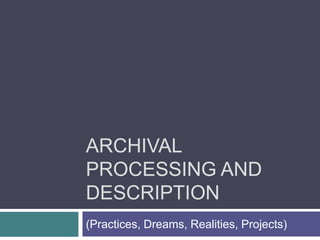
Archival Processing And Description
- 1. Archival Processing and Description (Practices, Dreams, Realities, Projects)
- 2. Library vs. Archives Materials Secondary sources Self-conscious creations Items collected and classified at individual level Items described according to well-established standards Primary sources Created in course of business/life Items collected and classified in aggregate Description standards only recently established Library (“neat”) Archives (“messy”)
- 3. Library Archive (Illustrated Visually)
- 4. Archival Functions Appraise Acquire Arrange Describe Preserve Make accessible [For this presentation, we are concentrating on arrangement and description]
- 5. Archival Arrangement 1) Variety: the only constant 2) Provenance 3) Original Order 4) Levels 5) Physical vs. intellectual order
- 6. Variety is the spice of archival life Collections vary greatly in size, format and complexity.
- 7. Provenance The context in which records were created is important to understanding historical significance, therefore- The materials generated by one individual, organization or department should not be combined with the materials of another. Examples: College of Agricultural Science Records Conrad Richter Papers Jack Rabin Collection on Alabama Civil Rights
- 8. Original Order Important in theory, but often violated in practice Materials should be kept in the order in which they were originally created, maintained or used. However, materials often come to us in no usable order.
- 9. Levels Collection, series, subseries Series often determined by subject, function, or form Within a series, filing system: chronological, geographical, alphabetical, etc.
- 10. Intellectual vs. physical order One intellectual series could include all materials on a selected topic, however those materials could be: papers (one area of stacks), books (another area of stacks), maps (require flat storage), and photographs (require cold storage) This complicates retrieval as well as arrangement and description.
- 11. Describe 1) Standards – DACS 2) Methods- Database tracking Finding aids Catalog records
- 12. DACS: Describing Archives, a Content Standard Some of the elements addressed by DACS: Required elements for different levels of description (minimum, optimum, added value) Title formation Forms of names Elements and examples of biographies and collection overviews (And much, much more)
- 13. Database tracking (Oliver homepage)
- 14. Oliver Screenshot 2 (HCLA collections)
- 15. Oliver Screenshot 3 (collection-items)
- 16. Finding Aids Information contained: Administrative information (extent, restrictions, etc.) Institutional History or Biography Collection overview Series Arrangement and Descriptions Box/folder lists Formats: Can be Word, PDF, HTML, EAD
- 17. Online Finding Aid Formats No metadata tagged, but information still online Findable through Google Searchable through “Find in page” Relatively quick and easy Metadata such as creator, subjects, date ranges all tagged Enables sharing with consortia and more precise retrieval Takes more time/training to encode Search software only in beginning stages HTML EAD
- 18. Examples HTML: Robert T. Oliver papers http://www.libraries.psu.edu/digital/findingaids/1086.htm EAD: T.R. Johns papers http://www.libraries.psu.edu/digital/findingaids/2/johns.frame.html
- 19. Robert T. Oliver Papers Finding Aid Screenshot
- 20. T.R. Johns Papers Finding Aid Screenshot
- 21. Sample EAD code <origination label="Creator"><persnameencodinganalog="100" source="lcnaf">Coit, Margaret L., 1919-2003</persname> </origination> <unittitle label="Title" encodinganalog="245">Margaret L. Coit Papers, <date type="inclusive" normal="1864/2003">1864-2003,</date> (bulk <date type="bulk" normal="1921/1999">1921-1999)</date></unittitle> <bioghist> <head>Biographical Note</head> <p><persname>Margaret Louise Coit</persname> was born 30 May 1919 in Norwich, Connecticut, to <persname>Archa Willoughby Coit</persname>, a stockbroker, and <persname>Grace Coit</persname> (nee Trow), the principal of a private day school. Two years later, Margaret's sister Grace was born with Down Syndrome. Caring for Grace would take up much of Coit's adult life.</p> <p> At the start of the Great Depression, Coit's family moved to <geogname>Greensboro, North Carolina</geogname>, where Coit attended <corpname>Curry School</corpname>, a training school located on the grounds of <corpname>Woman's College</corpname> (now the <corpname>University of North Carolina at Greensboro</corpname>, or <corpname>UNCG</corpname>). </p>
- 22. Catalog records
- 23. The Dream In the ideal “hierarchy of surrogacy”, we’d have finding aids for all collections that include item-level inventories, and catalog records that include collection-level summaries and point to those finding aids. Collection (tracked by database) described by finding aid summarized by catalog record
- 24. The cold hard reality (boo!) At Special Collections institutions in general* Processing time: mean of 14.8 hours per linear foot Backlog statistics: 34% of institutions say more than half of their collections are unprocessed, 60% at least a third unprocessed
- 25. (Cold, hard reality continued) At PSU Special Collections: About 75% of our collections are in the Cat About 30% of our collections have finding aids About 25% of our collections have neither (“hidden collections”)
- 26. *Meissner-Greene “More product, less process” (MPLP) Sacrifice detail in order to describe everything at collection level first, so that researchers know what you have Processing can be flexible, different levels between and within collections “Good processing is done with a shovel, not with tweezers”
- 27. Pertinent PSU Specoll Projects Core records Make catalog records at COLLECTION level for all Finding aids Generate HTML finding aids from Oliver Future plans New database system and more EAD
